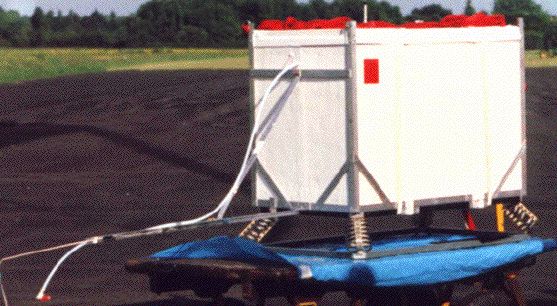Purpose of the flight and payload description
Is a Frost Point Hygrometer developed by the Laboratoire de Meteorologie Dynamique (LMD) of France in the late 80's for make "in situ" measurements of the contents of water vapor in the stratosphere. The weak water vapor contents, and the surrounding atmospheric conditions make this kind of measure very difficult and also its necessary to take many precautions to avoid pollution from the balloon and from the payload.
ELHYSA works by the so called chilled mirror technique, in wich the air enters the instrument and circulates over a cooled mirror. The occurrence of dew or white frost is detected in an optical way and the temperature of the mirror is maintained at the temperature of condensation by a feedback loop controlling the cooling and the heating of the mirror. This temperature, the dew or frost point temperature is directly connected to the partial pressure of water vapor that characterizes the water vapor content of the atmosphere. The simultaneous measurement of the air pressure and air temperature allows the determination of the mixing ratio and the relative humidity.
In a previous version of the instrument used prior 1994, the control of the temperature of the mirror was provided by a Peltier thermoelectric module, but it has several limitations so it was replaced by a cryogenic cooling system. In this new configuration the mirror is stuck on a copper rode plunging in liquid nitrogen enclosed in a dewar container, especially adapted, which provides a permanent cooling. The control of the mirror temperature is made through the adjustment of the heating of the mirror which is provided by a resistive wire rolled up around the copper rode. The use of cryogenic cooling made it possible to decrease considerably the response time of the hygrometer, compared to the Peltier instrument. The optical system and the associated mechanical structure remain the same ones as for the Peltier instrument as well the mirror and the embedded thermistor.
Details of the balloon flight
Balloon launched on: 10/22/2001 at 16:34
Launch site: Centre de Lancement de Ballons CLBA, Aire Sur L'Adour, Landes, France
Balloon launched by: Centre National d'Etudes Spatiales (CNES)
Balloon manufacturer/size/composition: Zero Pressure Balloon model 35SF Zodiac - 35.000 m3
Balloon serial number: 35 SF Nº 105
End of flight (L for landing time, W for last contact, otherwise termination time): 10/22/2001 at ~ 20:45
Balloon flight duration (F: time at float only, otherwise total flight time in d:days / h:hours or m:minutes - ): 4 h 13 m
Payload weight: 395 kgs
Gondola weight: 100 kgs
External references
- Balloon-borne observations of mid-latitude stratospheric water vapour: Comparisons with HALOE and MLS satellite data Journal of Atmospheric Chemistry 70(3), 2013
- Laboratoire de Météorologie Dynamique - The frost-point hygrometer - 1986-2005 Joëlle Ovarlez - March 2006
- Validation of GOMOS H2O Data Product with Balloonborne Laser and Frost-Point Hydrometers ENVISAT Validation Workshop (ESA SP-531). 9-13 December, Frascati, Italy
159If you consider this website interesting or useful, you can help me to keep it up and running with a small donation to cover the operational costs. Just the equivalent of the price of a cup of coffee helps a lot.


